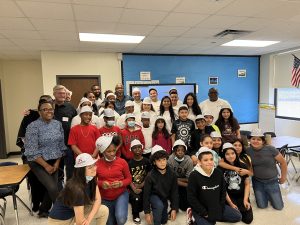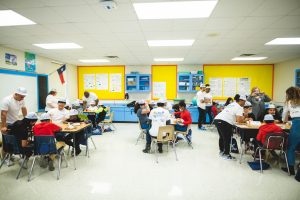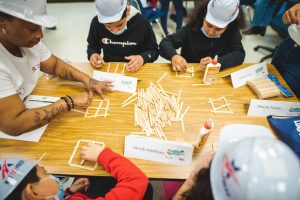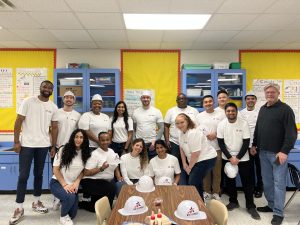
What do you get when you combine a bunch of engineers with a classroom full of eager elementary school children holding popsicle sticks and wood glue? Truss bridges, of course.
For the second year in a row, LBJ and North Tarrant Express (NTE) partnered with the Tackle Tomorrow Foundation and Dallas Independent School District’s STEM Department to bring an interactive STEM curriculum to
third through fifth graders in the district.
This isn’t just fun and games. These 20 students received an introductory course on civil engineering in transportation and bridge construction before being challenged with the ability to design and build a two-foot-long popsicle bridge able to withstand 75 pounds of paper. And they did!

Our Dallas group of 16 engineers and staff members coached the STEM Camp and Bridge Building event at Whitney M. Young Jr. Elementary School in February. Through this bridge-building exercise, our engineers taught these young minds the importance of planning, designing and coming up with an idea they can turn into reality to benefit society.
Using what they already know, what they learned that day and their creative minds, each student group built a bridge the judges tested for strength using reams of paper. The winning bridge held 340 pounds of paper without breaking! Who knows, 15 years from now one of these students might be the Cintra engineer volunteering at a school.
“We understand that ensuring that a robust pipeline of highly skilled personnel with backgrounds in math and science is essential to the success of our project and our industry,” said Robert Hinkle, LBJ Communication & Corporate Affairs Director.

Dallas ISD’s STEM Department provides opportunities like this for students and teachers to participate in science, technology, engineering and math events with community members. The district’s efforts pair with the goals of Tackle Tomorrow, a non-profit organization founded by five-time NFL Super Bowl Champion Charles Haley and Dallas civic leader Bob Bowie to provide young students with the resources and technology they need to overcome the literacy challenges that persist in underserved communities.
“These kids leave better than what they started,” said Haley, who attended the event and talked to the students.
